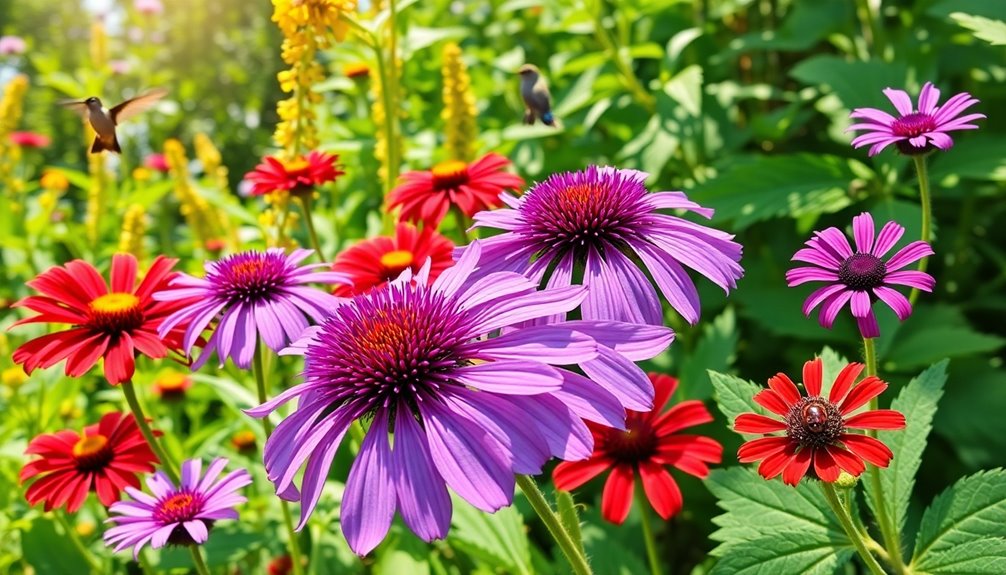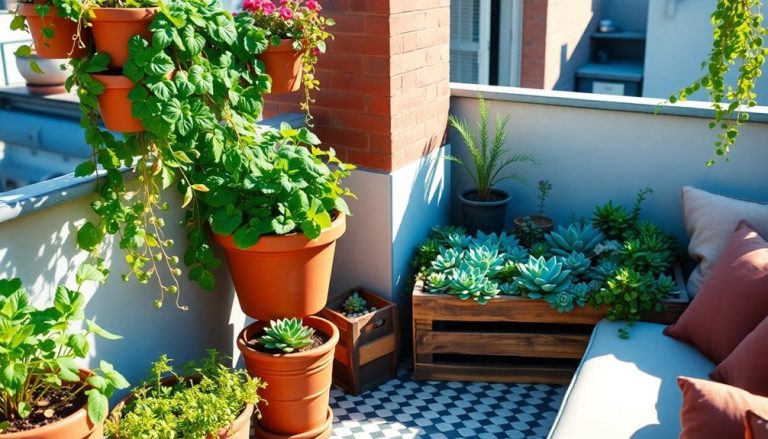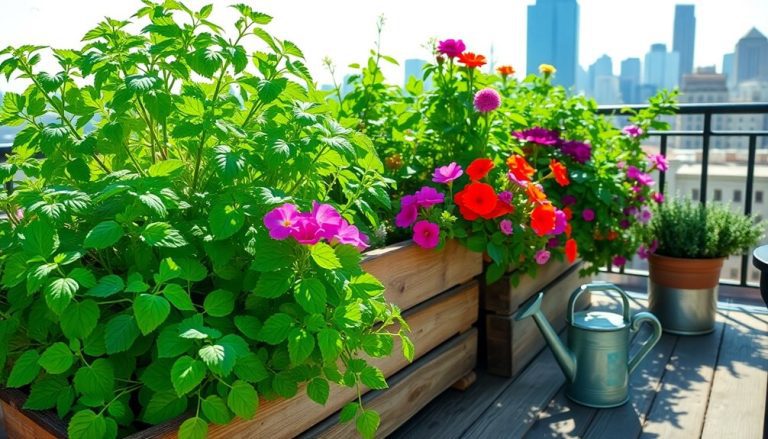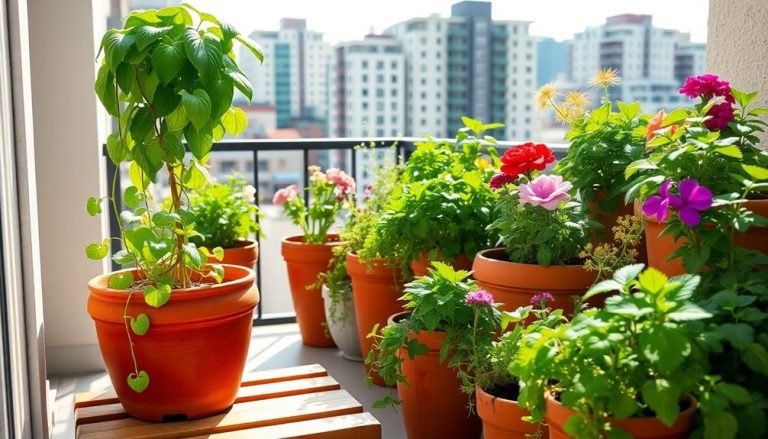If you're looking to attract wildlife, consider incorporating native plants into your garden. Top flowering options like coneflower and milkweed are great for butterflies, while shrubs such as serviceberry and elderberry provide food for birds. Don't forget grasses like little bluestem, which supports both birds and beneficial insects. For broader coverage, include trees like oak and dogwood to create a diverse habitat. Native plants require less maintenance and promote healthy ecosystems, so they're a perfect choice. Stick around to discover even more native plants that can enhance your wildlife-friendly garden.
Key Takeaways
- Coneflower (Echinacea) provides nectar for butterflies and seeds for birds, enhancing wildlife habitats.
- Black-eyed Susan (Rudbeckia hirta) attracts pollinators and is drought-resistant, making it ideal for low-maintenance gardens.
- Milkweed (Asclepias) is crucial for monarch butterflies and supports various pollinators while deterring unwanted insects.
- Serviceberry produces berries that attract birds, while its blooms offer early spring food sources for wildlife.
- Elderberry features clusters of flowers and dark berries, drawing pollinators and providing food for songbirds.
Benefits of Native Plants

Native plants offer numerous benefits that can enhance your garden and support local wildlife. By incorporating these plants into your landscape, you create a thriving ecosystem that attracts birds, butterflies, and beneficial insects. These species rely on native plants for food and shelter, helping to maintain biodiversity in your area.
One major advantage of native plants is their low maintenance requirements. Since they're adapted to your local climate and soil conditions, they need less water, fertilizer, and pesticides compared to non-native varieties. This not only saves you time and money but also reduces your environmental impact. Additionally, effective pest control solutions can be more easily achieved with native plant species, as they often attract natural predators of common pests.
Additionally, native plants help improve soil health. Their deep root systems prevent erosion and promote better water infiltration, leading to healthier, more resilient soil. Furthermore, utilizing native plants can help reduce the need for organic pest control solutions, creating a more sustainable gardening approach.
You'll notice a decrease in invasive species as native plants flourish, creating a balanced habitat.
Top Flowering Plants
When choosing flowering plants for your garden, consider options that not only brighten your landscape but also support local wildlife. Selecting native flowering plants can attract pollinators like bees and butterflies, as well as provide food for birds and other animals. Additionally, incorporating insect-repelling plants can help protect your garden from pests.
Here are three top choices you should think about:
- Coneflower (Echinacea): This hardy perennial not only adds vibrant color to your garden but also attracts butterflies and provides seeds for birds in the fall. Furthermore, it can thrive in various conditions, making it a versatile addition to your landscape.
- Black-eyed Susan (Rudbeckia hirta): With its striking yellow petals and dark centers, this plant blooms reliably and invites various pollinators while offering seeds for wildlife. Its resilience also means it can withstand drought, making it an excellent choice for low-maintenance gardens.
- Milkweed (Asclepias): Essential for monarch butterflies, milkweed serves as a host plant for their larvae and attracts many other pollinators. Additionally, incorporating edible flower seeds can enhance your garden's biodiversity and provide unique culinary options. Notably, milkweed can also help deter unwanted insects, further benefiting your garden ecosystem.
Essential Shrubs for Wildlife
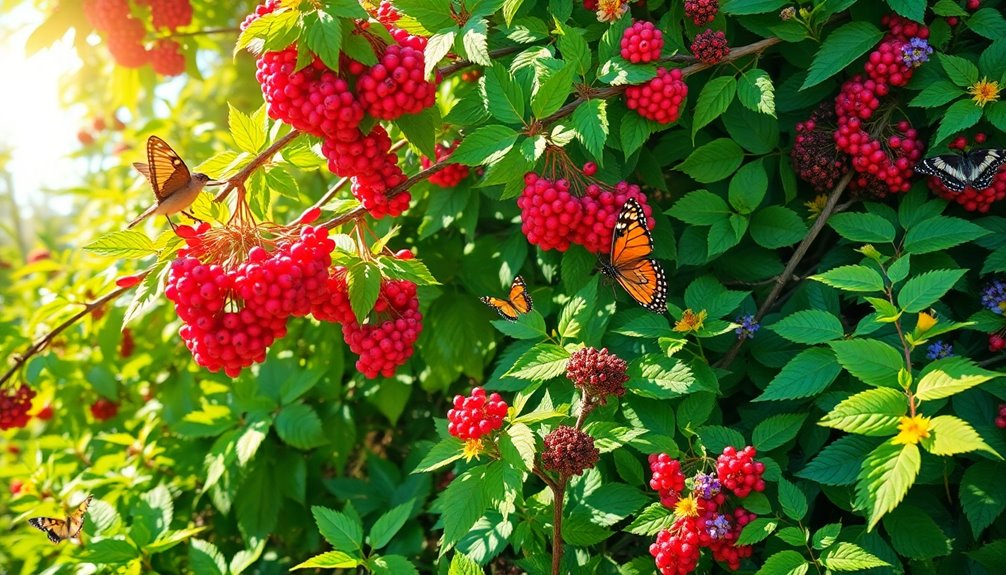
Incorporating essential shrubs into your garden can create a thriving habitat for wildlife. These plants provide food, shelter, and nesting sites for various creatures. When selecting shrubs, consider native species that are well-suited to your region, as they'll attract local wildlife more effectively.
One excellent choice is the serviceberry, which offers beautiful blooms in spring and delicious berries in summer. Birds and small mammals love to feast on its fruit.
Another great option is the elderberry, known for its clusters of flowers and dark berries that attract pollinators and songbirds alike.
If you want to support butterflies, plant spicebush. Its leaves serve as a host for the spicebush swallowtail caterpillar, while the fragrant yellow flowers draw in pollinators.
Don't overlook black chokeberry, either. Its white flowers and glossy black berries provide food for various birds and other wildlife.
Lastly, consider the beauty of viburnum species, which produce berries that many birds enjoy. Additionally, using seed starting kits can help you cultivate these essential shrubs from seeds, ensuring a healthy start for your wildlife garden.
Grasses to Attract Pollinators
Enhancing your garden with native shrubs not only supports wildlife but also sets the stage for including grasses that attract pollinators.
Grasses play a crucial role in your garden's ecosystem, providing essential food and habitat for various pollinators, including bees and butterflies.
Here are three excellent native grasses that can help you achieve this:
- Little Bluestem (Schizachyrium scoparium): This resilient grass offers seeds that feed birds and provides shelter for insects.
- Eastern Gamagrass (Tripsacum dactyloides): Its tall, lush growth attracts various pollinators and offers a fantastic backdrop for other plants.
- Switchgrass (Panicum virgatum): This adaptable grass can thrive in various conditions, attracting butterflies with its flowering spikes.
Trees That Support Ecosystems
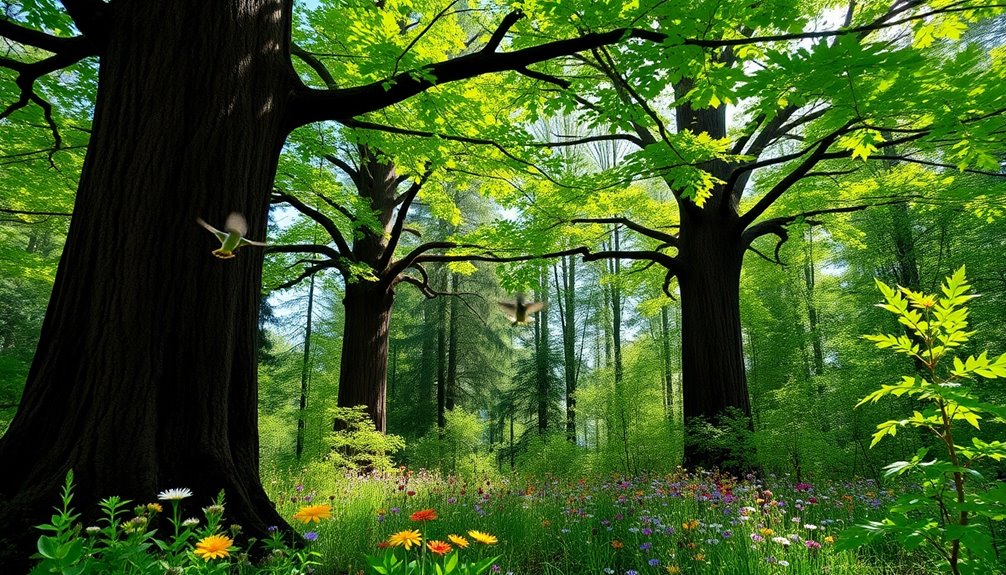
Supporting ecosystems starts with choosing the right trees for your garden. Native trees not only enhance your landscape but also provide essential habitat and food sources for wildlife. By selecting trees that thrive in your region, you'll create a rich environment that supports local ecosystems.
Here are three trees you should consider:
| Tree Name | Wildlife Benefits | Ideal Growing Conditions |
|---|---|---|
| Oak | Supports over 500 species of insects and birds | Well-drained soil, full sun |
| Maple | Attracts pollinators with its flowers | Moist, well-drained soil, partial shade |
| Pine | Provides shelter and food for various birds | Well-drained soil, full sun to partial shade |
Planting these trees can significantly impact local wildlife. They not only serve as a food source but also provide nesting sites and shelter. When you choose native species, you're helping to preserve the natural balance in your area. So, start planting these trees, and watch as your garden transforms into a thriving ecosystem that benefits both you and the wildlife around you.
Ground Covers for Biodiversity
Choosing the right ground covers can further enrich your garden's biodiversity. By selecting native plants for this purpose, you create habitats that support various forms of wildlife, from pollinators to small mammals.
Ground covers not only suppress weeds but also help retain moisture and improve soil health. Here are three excellent options to consider:
- Creeping Thyme: This fragrant herb attracts bees and butterflies while forming a dense mat that prevents weeds.
- Wild Strawberry (Fragaria vesca): These plants offer delicious fruit for both you and local wildlife, plus they provide excellent ground coverage.
- Pachysandra: Ideal for shady areas, this evergreen ground cover supports various insects and provides year-round greenery.
When you incorporate these native ground covers into your landscape, you'll not only beautify your garden but also create a thriving ecosystem.
Each of these plants plays a role in supporting local fauna, ensuring your garden contributes to the broader environment. Embracing ground covers for biodiversity is a rewarding step toward a more sustainable and wildlife-friendly garden.
Tips for Planting Native Species
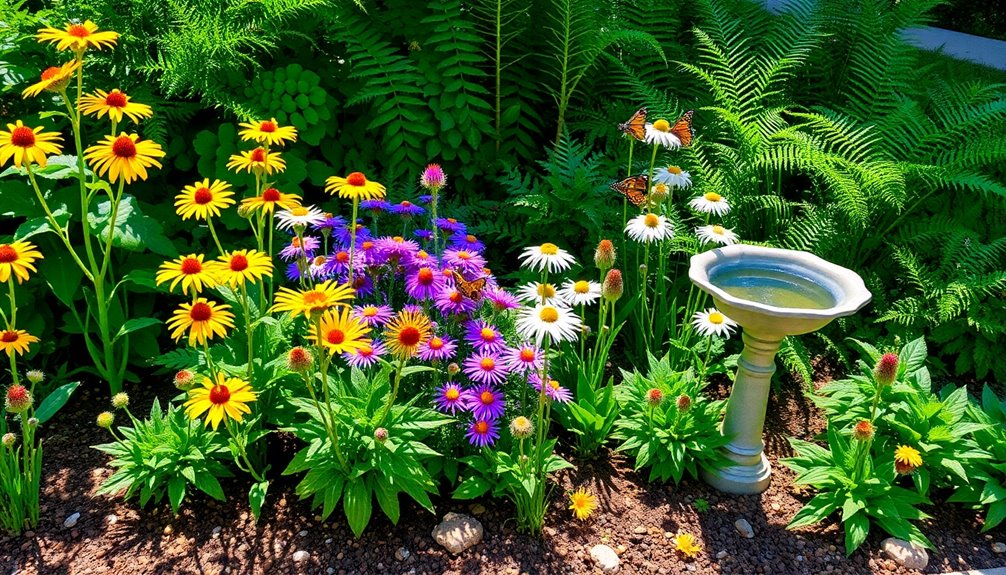
Planting native species can significantly enhance your garden's ecological balance and attractiveness. Start by researching the native plants suited to your local climate and soil conditions. Visit local nurseries or botanical gardens to find species that thrive in your area.
When selecting plants, consider their blooming seasons and growth habits to create a garden that offers year-round interest for wildlife.
Before planting, prepare the soil by removing weeds and debris. This creates a healthy environment for your native plants to establish. Dig holes that are twice as wide as the root ball but no deeper, allowing roots to spread easily.
Space plants appropriately to prevent overcrowding and promote airflow.
Water your newly planted natives deeply but infrequently, encouraging deep root growth. Mulching around the plants helps retain moisture and suppress weeds. Once established, native plants require less maintenance than non-natives, as they're adapted to local conditions.
Finally, create a diverse habitat by incorporating a mix of plants at different heights. This will attract a variety of wildlife, from pollinators to birds, enriching your garden with life and beauty.
Enjoy watching your native garden thrive!
Frequently Asked Questions
How Do I Choose Native Plants for My Specific Region?
To choose native plants for your region, research local climate, soil types, and native ecosystems. Visit local nurseries or extension offices for recommendations, and consider plants that attract pollinators and support local wildlife's needs.
Can Native Plants Be Invasive in Some Areas?
You might think native plants are always safe, but some can become invasive in certain areas. These plants can outcompete local species, disrupting ecosystems. It's crucial to research before planting in your specific region.
What Is the Maintenance Level for Native Plants?
The maintenance level for native plants is generally low. You'll find they adapt well to local conditions, requiring less water and fewer chemicals. Regular weeding and occasional pruning will keep them thriving without much effort.
How Do Native Plants Impact Local Soil Health?
Native plants enrich local soil health like a warm blanket nurtures a sleeping child. Their deep roots improve structure, enhance nutrient cycling, and foster beneficial microorganisms, creating a thriving ecosystem that supports both plants and wildlife.
Are There Native Plants That Deter Pests Naturally?
Yes, certain native plants naturally deter pests. For instance, you can grow marigolds or lavender, as their scents repel unwanted insects. Incorporating these plants into your garden helps maintain a healthier ecosystem without harsh chemicals.
Conclusion
By choosing native plants, you're not just beautifying your space; you're creating a thriving habitat for wildlife. Did you know that planting even a small patch of native flowers can significantly boost local pollinator populations? It's true! Each native species plays a vital role in the ecosystem, supporting everything from bees to birds. So, whether you're adding a few flowering plants or an entire garden, you're making a difference—one plant at a time.

